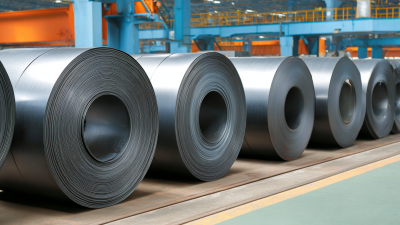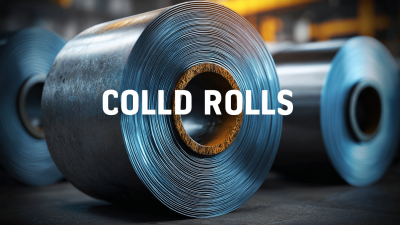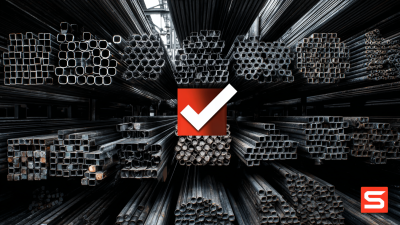In the competitive landscape of manufacturing and supply chain management, sourcing strategies play a pivotal role in achieving cost efficiency and operational excellence. Cold Rolled Coils, a vital material used across various industries, from automotive to construction, present unique sourcing challenges and opportunities.

According to a report by Grand View Research, the global cold rolled steel market is projected to reach USD 440.95 billion by 2025, highlighting the growing demand and the necessity for manufacturers to optimize their sourcing practices.
Implementing best practices in the procurement of Cold Rolled Coils could lead to significant cost savings, estimated at around 20%, as firms increasingly look to optimize their supply chains for better margins. This blog will guide you through five essential best practices for sourcing Cold Rolled Coils effectively, ensuring your organization not only meets demand but also improves its financial performance.
Cold rolled coils
are a critical component in various manufacturing processes, known for their appealing surface finish and enhanced mechanical properties compared to hot rolled alternatives. The process of cold rolling involves reducing the thickness of steel at room temperature, which not only increases its strength but also improves its dimensional accuracy. Understanding the intricacies of this market is essential for businesses looking to optimize their supply chain and achieve significant cost savings.
Market dynamics for cold rolled coils
are influenced by various factors, including demand fluctuations, raw material prices, and global trade policies. Manufacturers must stay informed about trends affecting the steel industry, such as changes in consumer preferences and technological advancements. By assessing these elements, companies can make more strategic sourcing decisions, ensuring they source high-quality coils at competitive prices. This knowledge empowers businesses to navigate market challenges effectively, ultimately leading to improved profitability and sustainability in their operations.
When sourcing cold rolled coils, evaluating key factors is crucial to ensuring both quality and cost efficiency. First and foremost, assess the supplier’s manufacturing capabilities. It's essential to partner with a supplier that employs modern technology and quality control processes, as this directly influences the coil's physical properties and overall performance. Examine their certifications and industry standards compliance, which can often indicate reliability and consistency in product quality.
Additionally, consider the material specifications and tolerances that fit your requirements. Understanding the alloy composition and how it correlates to your application can prevent costly mistakes down the line. Don't hesitate to request samples; this can provide a firsthand look at the coil's surface finish and mechanical properties, allowing you to make informed decisions.
Finally, negotiate not just on price, but also on terms like delivery schedules and payment conditions. Building lasting relationships with suppliers can lead to additional advantages, such as priority service or reduced lead times. Keep an open line of communication to foster cooperation that will benefit your supply chain in the long run.
Effective supplier relationship management is crucial for achieving significant cost reductions in sourcing cold rolled coils. Building strong partnerships with suppliers not only enhances communication but also fosters collaboration throughout the supply chain. By understanding each other's needs and constraints, both parties can work towards mutually beneficial agreements that leverage volume discounts, improve delivery schedules, and minimize lead times. Regularly engaging with suppliers through performance reviews and feedback sessions can identify areas for improvement and innovation, leading to cost-effective solutions.
Additionally, implementing a structured supplier evaluation process can help businesses identify the best partners for their sourcing strategies. This involves assessing suppliers based on quality, reliability, and flexibility in meeting demand changes. By nurturing relationships with high-performing suppliers, companies can tap into their expertise, which may lead to process optimizations and product innovations that further lower costs. Moreover, maintaining an open line of communication ensures that both buyers and suppliers can quickly address potential issues, thus preventing disruptions and additional expenses in the supply chain.
In today's competitive market, leveraging technology for cold rolled coil procurement is essential for achieving significant cost savings. According to a recent industry report from Grand View Research, the global cold rolled steel market size was valued at approximately $362 billion in 2022, and it's projected to grow steadily. Implementing digital tools can streamline the sourcing process, enhance supplier collaboration, and provide real-time pricing data, allowing companies to make informed purchasing decisions that can lead to cost reductions of up to 20%.
Tip: Adopt a centralized procurement platform that integrates with suppliers' systems. This integration not only facilitates better communication but also helps in tracking price fluctuations and inventory levels, enabling your team to capitalize on bulk purchasing opportunities.
Moreover, utilizing data analytics can provide insights into market trends and supplier performance. By analyzing historical purchasing data, companies can identify patterns and predict future demands. According to McKinsey, businesses that invest in predictive analytics can improve their procurement efficiency by as much as 30%.
Tip: Regularly assess and update your digital tools to ensure they meet industry standards and align with your strategic goals. Automation and machine learning can significantly enhance your sourcing efficiency, freeing your team to focus on strategic initiatives rather than manual processes.
In today’s competitive market, thoroughly analyzing the Total Cost of Ownership (TCO) is essential for informed supply chain decisions, especially in sourcing cold rolled coils. By understanding TCO, companies can uncover hidden costs, such as maintenance, logistics, and quality, thereby unlocking potential savings. A recent report suggests that organizations focusing on TCO can realize up to 20% cost savings, aligning budgeting with long-term operational efficiency.
Moreover, the broader implications of digital transformation in supply chains, such as the adoption of digital twin technology, are noteworthy. For example, leading logistics companies are leveraging real-time digital models to enhance their supply chain visibility and responsiveness. This approach not only reduces inefficiencies but also supports better risk management, a critical factor highlighted in the Dun & Bradstreet’s AI-driven solutions for supplier risk assessments. As industries evolve, integrating comprehensive assessments of TCO with cutting-edge technologies will be key to optimizing supply chain performance and achieving significant cost savings.
This chart illustrates the potential cost savings achieved through various best practices in sourcing cold rolled coils. The data reflects savings in percentage from the Total Cost of Ownership perspective across different strategies.









